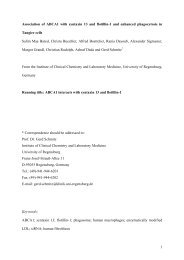SUNDAY, DECEMBER 4- Late Abstracts 1 - Molecular Biology of the ...
SUNDAY, DECEMBER 4- Late Abstracts 1 - Molecular Biology of the ...
SUNDAY, DECEMBER 4- Late Abstracts 1 - Molecular Biology of the ...
Create successful ePaper yourself
Turn your PDF publications into a flip-book with our unique Google optimized e-Paper software.
<strong>SUNDAY</strong><br />
Galán C, Dionisio N, Smani T, Salido GM, Rosado JA. The cytoskeleton plays a modulatory role<br />
in <strong>the</strong> association between STIM1 and <strong>the</strong> Ca2+ channel subunits Orai1 and TRPC1. Biochem<br />
Pharmacol. 2011;82:400-10.<br />
Nuclear Structure and Function<br />
2013<br />
Proteostatic control <strong>of</strong> nuclear targeting pathways by <strong>the</strong> nuclear pore complex protein,<br />
Nup42.<br />
L-K. LIU 1 , C-C. LIN 1 , D. S. Goldfarb 1 ; 1 <strong>Biology</strong>, University <strong>of</strong> Rochester, Rochester, NY<br />
Multiple transport receptors ferry nuclear localization signal (NLS)-bearing cargos across <strong>the</strong><br />
nuclear pore complex (NPC). The FG-domains <strong>of</strong> nucleoporins in <strong>the</strong> NPC are thought to be<br />
required in specific combinations for efficient transport receptor-mediated transports. A model <strong>of</strong><br />
multiple independent NPC translocation routes exist for different transport receptors was<br />
presented. Based on this model, direct competition for <strong>the</strong> same translocation pathway shared<br />
by multiple transport receptors can be expected. In this study, we have found that Nup42<br />
governs a unique stress response that differentially controls import mediated by Kap95/60 and<br />
Kap104. In vivo kinetic analyses show that Kap95/60 and Kap104 compete for limiting docking<br />
sites at Nup42. Binding to Nup42 is <strong>the</strong> rate-limiting step in import, since <strong>the</strong> import rates <strong>of</strong><br />
Kap95/60 and Kap104 NLS-cargos are faster in nup42 DFG cells. Nup42 collaborates with <strong>the</strong><br />
Hsp70s Ssa1/Ssa2 (but not Ssa3/Ssa4) and <strong>the</strong> co-chaperone Swa2 to differentially control<br />
nuclear targeting by Kap95/60 and Kap104. Specifically, Kap95/60 import is favored over<br />
Kap104 import when Ssa1/Ssa2 levels are high, such as in response to heat shock or nutrient<br />
depletion. In contrast, Kap104 import is favored when <strong>the</strong> free Hsp70 pool is depleted, for<br />
example, by sequestration into Huntingtin polyQ protein aggregates. Kap123-mediated import<br />
rates are unaffected by this regulatory circuit. Here we present <strong>the</strong> first evidence that two<br />
specific transport receptors, Kap95/60 and Kap104, share and compete for similar translocation<br />
route in <strong>the</strong> NPC. We also conclude that Nup42 is a Kap-specific gatekeeper that controls<br />
import rates in response to proteostatic stress.<br />
2014<br />
Evidence <strong>of</strong> asymmetric assembly pathway <strong>of</strong> Nuclear Pore Complex.<br />
P. Colombi 1 , C. Vogel 1 , P. Lusk 1 ; 1 Department <strong>of</strong> Cell <strong>Biology</strong>, Yale School <strong>of</strong> Medicine, New<br />
Haven, CT<br />
In an effort to investigate regulatory mechanisms governing nuclear pore complex (NPC)<br />
assembly, we investigated alterations in <strong>the</strong> subcellular distribution <strong>of</strong> multiple nucleoporins<br />
(Nups) through <strong>the</strong> cell cycle in <strong>the</strong> budding yeast S. cerevisiae. Consistent with <strong>the</strong> idea that<br />
NPC assembly is under <strong>the</strong> control <strong>of</strong> cell cycle regulators, we observe that several specific<br />
Nups accumulate in <strong>the</strong> cytoplasm <strong>of</strong> cells arrested in S-phase but not in G1. Interestingly,<br />
<strong>the</strong>se likely NPC intermediates accumulate asymmetrically between <strong>the</strong> mo<strong>the</strong>r and bud and<br />
appear to be strikingly biased towards <strong>the</strong> bud, <strong>of</strong>ten accumulating at <strong>the</strong> bud cortex. These<br />
intermediates can <strong>of</strong>ten be observed integrating into <strong>the</strong> daughter cell nuclear envelope during<br />
anaphase supporting <strong>the</strong> idea that <strong>the</strong>re is a pathway in which Nups are specifically targeted to<br />
<strong>the</strong> bud to be incorporated in <strong>the</strong> NPC <strong>of</strong> <strong>the</strong> daughter cell. Perturbing this pathway by<br />
conditionally sequestering specific newly syn<strong>the</strong>sized Nups results in a decrease in <strong>the</strong> size <strong>of</strong><br />
daughter nuclei. Most strikingly, <strong>the</strong>se daughter cells are no longer able to progress through <strong>the</strong><br />
cell cycle, whereas <strong>the</strong> mo<strong>the</strong>r cells continue to divide. Toge<strong>the</strong>r <strong>the</strong>se results support <strong>the</strong>
















